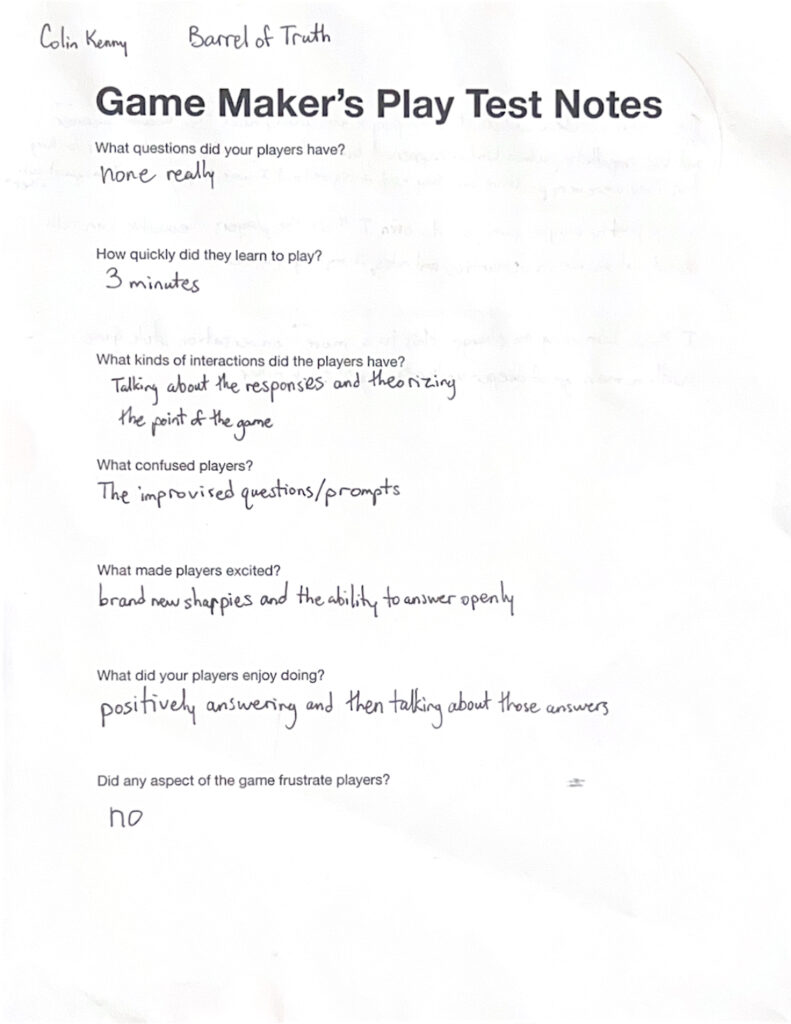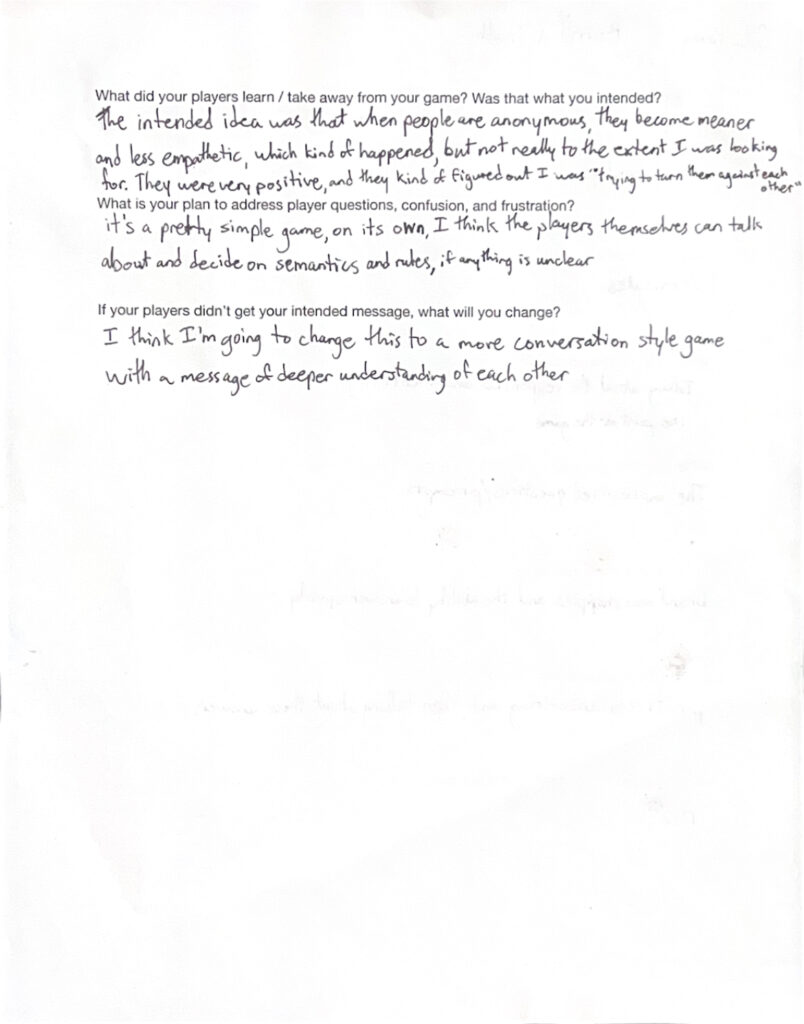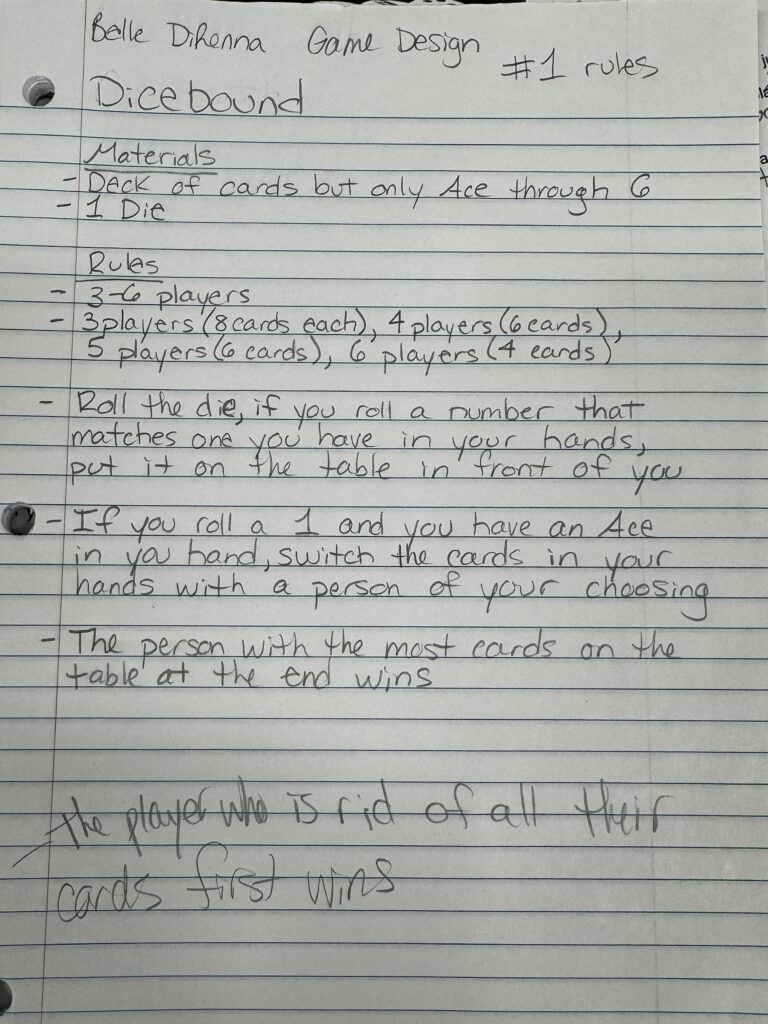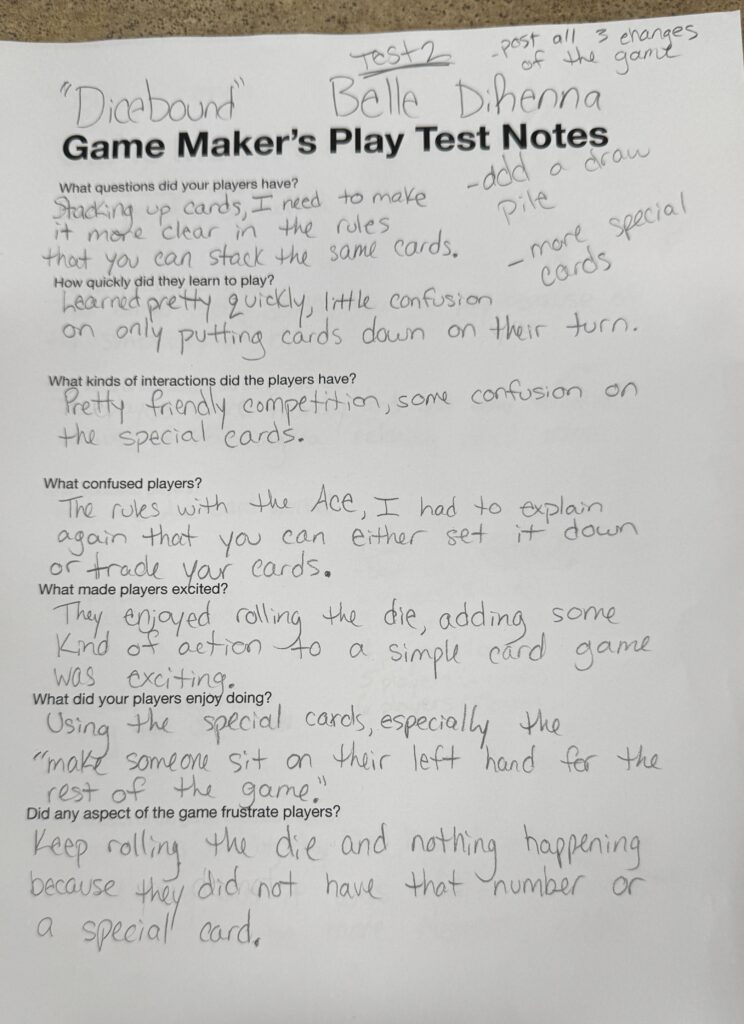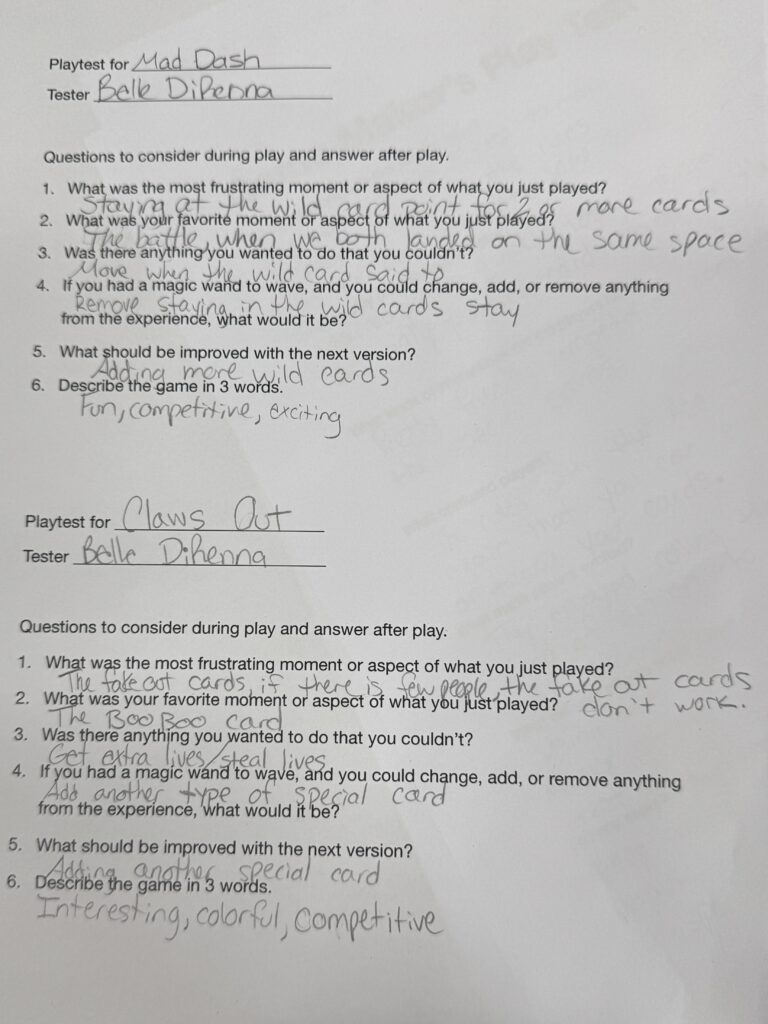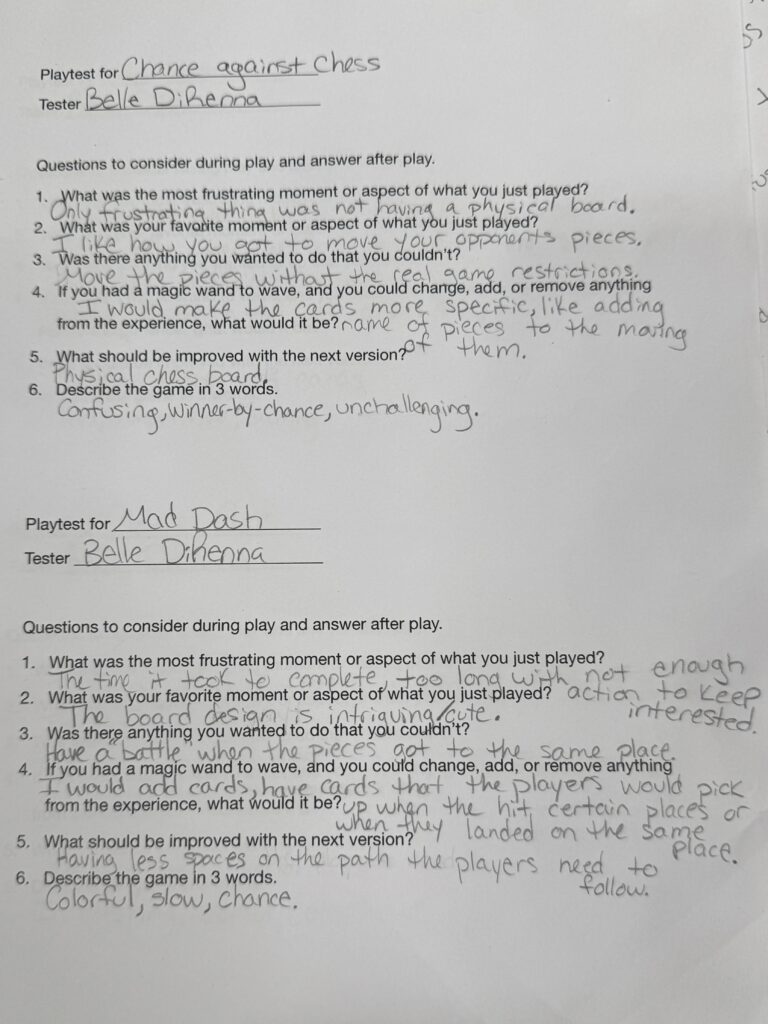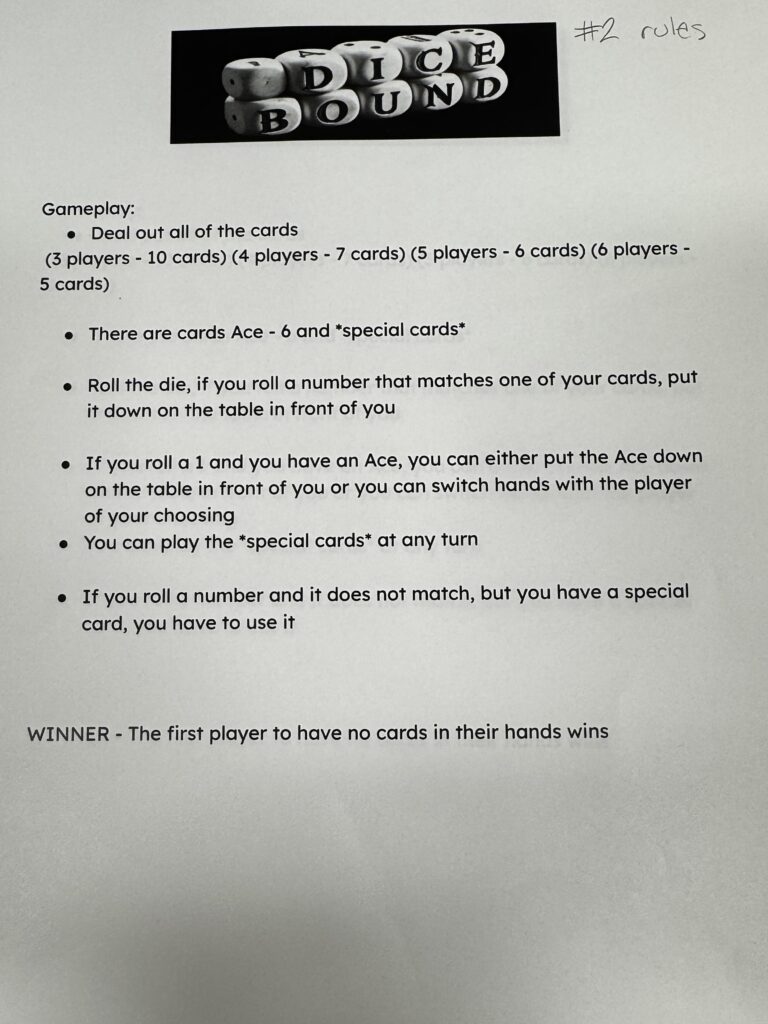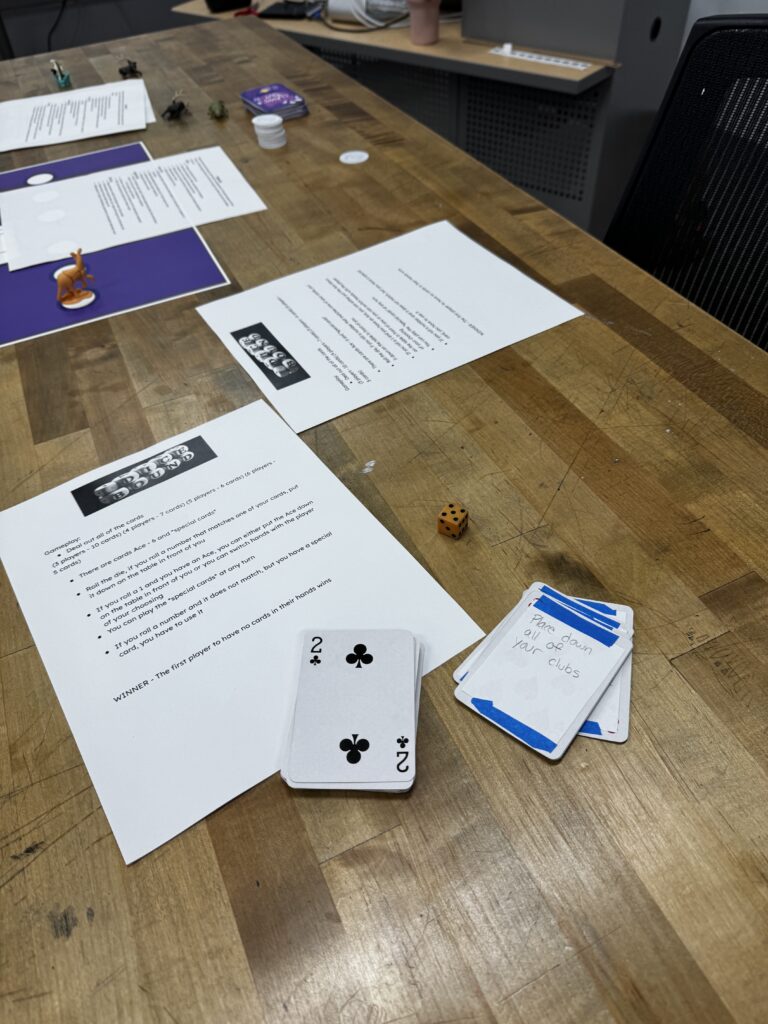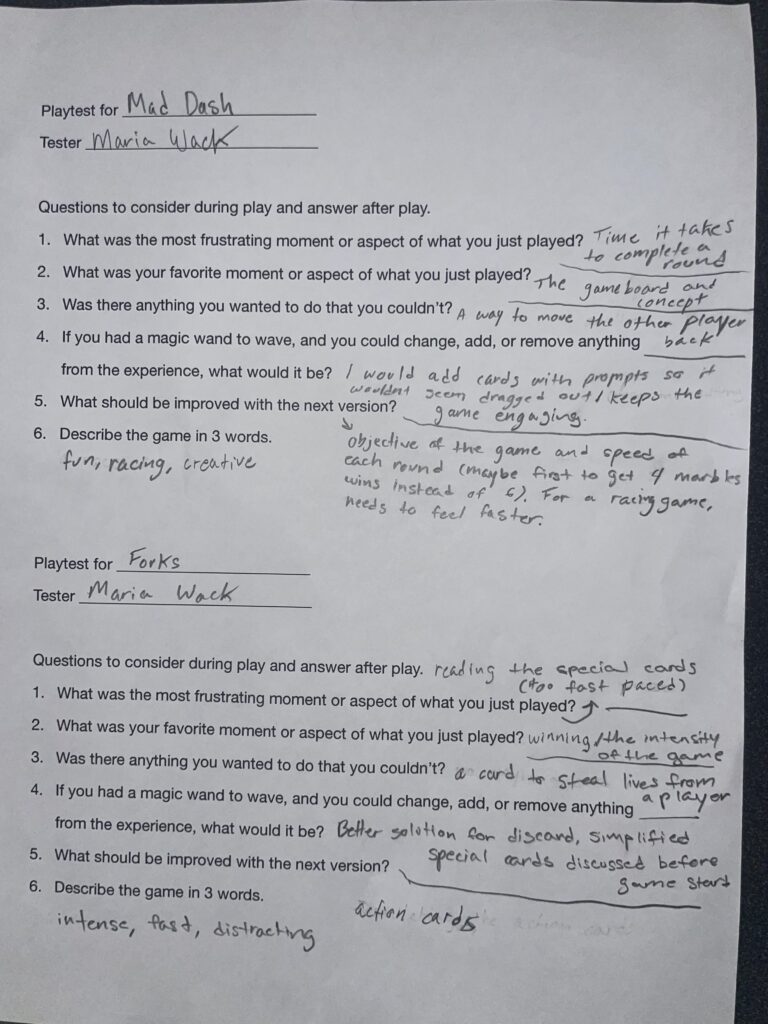by Evelyn, Colin, and Tori
Game Design 2 Class Game Test
What was the most frustrating aspect? Not understanding how my game multipliers affected my score.
What was your favorite moment? Playtesting ( I really like Hues n Cues)
Was there anything you wanted to do? Maybe points for perceived time invested in game prototypes. I’ve played prototypes that have a huge amount of thought, time, and resources invested. This might already exist.
If I had a magic wand to change, add or remove? Maybe differentiation from Game Design 1. It feels very similar in layout in lectures, projects, and outcome and not sure how much additional information I gained from an educational perspective.
If this game scoring is kept for future classes, it would be cool to have the score on a website. It could show what multipliers you have and how it effects your score.
What should be improved? I feel like the complexity of certain games versus others isn’t taken into consideration with the final prototype scoring system. I could be wrong, but it seems like a simple card game and a very complex coded game would get the same score. The way it’s currently set up, I feel like it’s encouraging producing quick, easy games. Specifically for a games for change class, it becomes harder to produce impactful, polished, or researched games.
Game Message? Iteration is king. You must test your ideas, get feedback, and provide feedback.
Game in 3 words? experimental, creative, prototypes
Dot’s Home Game Review
What was the most frustrating aspect? The players had very few choices. There was little guidance or motivation to finish.
What was your favorite moment? Finding the wallet. it was a moment where the user actually can interact with elements of the game. you could move parts of the wallet around to see family pictures.
Was there anything you wanted to do? I really wanted to do more things in this game. It really was just a click through choose your own story game. I wanted puzzles or more interactive elements of consequence.
If I had a magic wand to change, add or remove? More interactions. Perhaps elements that will help enhance the time you travel back to? When traveling to the 1950s, it would be nice if there was a radio that would play music from the time period. There was a street that players could walk down but there wasn’t really anything to interact with.
What should be improved? More interactions as said. I think it would attract more people to play the game.
Game Message? 1. Individual choices could effect your family for generations. 2. Effects of race on the real estate market since thee 1950s.
Game in 3 words? real-estate, racial awareness, family heritage
Barrel of Truth Version 2 Rules -Colin Kenny
All players are given a pen and piece of paper per round. On their turn, players draw a card and read it aloud to the group, as well as its category, either public or anonymous. If public, all players write their names in the corner of their paper. If anonymous, players should only write their answers. Once everyone is finished, they drop their papers into the barrel, the card drawer closes the lid, shakes it well, then removes the lid and reads all of the responses. Then, players are encouraged to discuss and have meaningful conversations regarding the topic and responses. Play continues clockwise. Play ends when players feel they know each other much better.
Rules for Barrel of Truth (Version 1)- Colin Kenny

Each player is given a Sharpie or any type of pen, but all of them must be identical. Each round, the host (me) hands each player a slip of paper and asks them to respond to a question or prompt pertaining to the other players. It can be in the form of an assumption, and opinion, a secret, etc. No direction is given whether the responses SHOULD be positive or negative. Some rounds will require players to write their own names on their slips along with their answers, other round they must be completely anonymous. After every player has answered, they will put their slip in the barrel, the barrel is closed and mixed, and each answer is read aloud by the host. The players are suggested to share thoughts and feelings of the responses. Once everyone is ready, the next round begins. The game ends whenever the players either hate each other or get bored.
Play Test Notes for Barrel of Truth- Colin Kenny
Review of Sara and Amber’s Game, Cry Me A Pond- Colin Kenny
Educational Game Questions
- What are the challenges a team faces when working on an educational game? Each team member might have different priorities within game production. Content experts might want in depth background text, game designers want an interactive and compelling experience, while pedagogy experts believe it must be the ultimate teacher. The challenge is coordinating expertise and perspectives to create a final product that balances them all.
- In the case study team members vetoed each others game ideas, what were the scientist’s, pedagogy expert’s and designer’s issues? The game designer immediately dismissed game ideas proposed by the pedagogy expert and scientist because they did not constitute “a game.” The scientist immediately rejected many of the game designer’s ideas because the science was incorrect. The pedagogy expert didn’t like the idea of levels as it inhibited learning
- What did the team learn from play testing their prototypes?
- The scientist learned that extinct animals are not so intrinsically interesting that players will want to learn more about them naturally (solution: less educational information immediately provided rather than a lot of optional info)
- Levels were needed for motivation and maintained engagement
- A certain card mechanic was not adding to the learning benefit in replayability so it was substituted
- Reduced irrelevant information that distracted and decreased engagement
- When more customized feedback was provide to users, they felt more engaged and like they were learning more.
- How does play testing resolve conflicts among team members? Game testing is an objective way of proving what works and what does not. It actively tests each person’s perspective and proves its value.
Dicebound Game Design
Review of Sara’s Don’t Judge a Book by it’s Cover
Review of Gideon’s The Unseen Directive – Colin Kenny
- What was the most frustrating moment or aspect of what you just played? Trying to scan the QR codes and then being met with requesting access to a Google Drive every time, and the thinness of the paper making it difficult to pull a card out and put it on the table.
- What was your favorite moment or aspect of what you just played? The narrative and the reveal at the end were very clever. I played with Kelsey, and throughout the game we new something was up and that the colors and the action of grabbing the right color meant something, we just didn’t know what.
- Was there anything you wanted to do that you couldn’t? Well maybe being able to read all of the cards but for time we couldn’t.
- If you had a magic wand to wave, and you could change, add, or remove anything from the experience, what would it be? It would be cool to see this as a computer game or something that doesn’t require a moderator to give the list of colors.
- What should be improved with the next version? Better materials and better graphics, but I’m confident Gideon can do that.
- Describe the game in 3 words. Color Match Mystery
Review of Ames’s Civilization Simulation Game – Colin Kenny
- What was the most frustrating moment or aspect of what you just played? The lack of knowledge of what we were “supposed” to be doing. The testing phase for this game still felt very loose.
- What was your favorite moment or aspect of what you just played? I liked the dedicated 3D printing style. The pieces and board just had this interesting aesthetic that brought me into the world a little more. I also enjoyed taking out the civilians before they could reach the edge of the board and adding them to my collection.
- Was there anything you wanted to do that you couldn’t? I’ll be honest, I did kind of fudge the number of moves I had to do the things I wanted to do. It was hard with 6 players taking loooooong turns to think ahead and make moves that feel like you are actually progressing.
- If you had a magic wand to wave, and you could change, add, or remove anything from the experience, what would it be? I would try my best to keep the turns moving quickly somehow, or just limit the max number of players.
- What should be improved with the next version? I don’t think we were necessarily the right audience for this game, but if it was for us I would say simplification of things like goals, actions, amount of times you could roll the dice, etc.
- Describe the game in 3 words. We Live Inasociety
Game Maker Play Notes Part 2 Sammy Homer
First version:
This game is a card game that was originally called Animal Pickup which had player’s pick-up abilities and have a chance of getting animal cards. Once you get all of your colored animal cards then the player win.
I realized I needed way more ability cards with different uses, less animal cards, and a way to get different colored animals out of a player’s hand
Second version:
I change the name to Critter Picker and change the goal to have 2 sets of colored cards to win (instead of specific-colored cards). I’ve also added abilities to animal cards that only activate if the player has the specific color. Additionally, I made it so there’s an animal pile and an ability pile instead of it being intermingled.
I realized I need a better way of showing the animal pile vs the ability pile as well as adding or lessening some ability cards. I’ve also realized having 2 sets of colored cards may be a bit much especially for 2 players. Additionally, I need balance some card abilities and have clearer instructions (especially on the cards)

